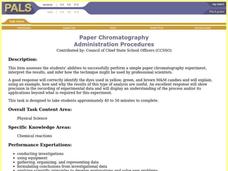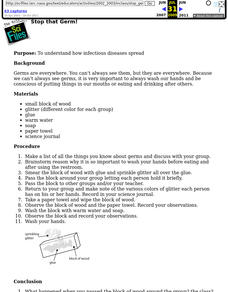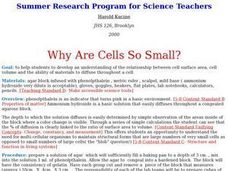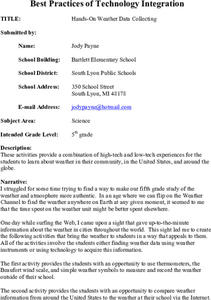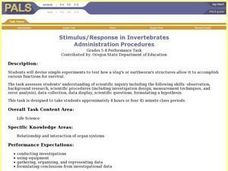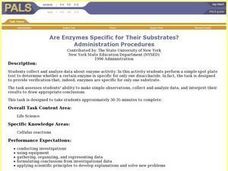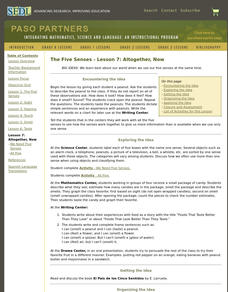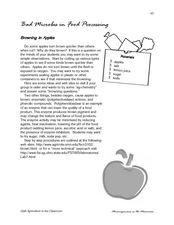Curated OER
Paper Chromatography
Small groups of learners perform paper chromatography to separate food dyes into their component colors. Students perform the experiment and collect, organize, and represent their data to form an explanation of their outcomes. Learners...
Curated OER
Capillary Action And Transpiration
Students engage in a study of the concepts of biology with plants known as capillary action and transpiration. They conduct a simple experiment to demonstrate the concept. The lesson includes a background discussion led by the teacher...
Curated OER
Stop that Germ!
Young scholars experiment with glitter to explain the importance of washing hands and how germs are distributed. After a lecture/demo, students perfom a simple experiment which clearly demonstrates how germs are spread.
Curated OER
Why Are Cells So Small?
Students examine the relationship between cell surface area and the ability of materials to diffuse through a cell. They participate in an experiment in which they determine which materials diffuse easier than others. They complete...
Curated OER
Hands-On Weather Data Collecting
Fifth graders use Internet sites to complete a study of weather and atmosphere. They compare weather data from cities around the world. They use thermometers, the Beaufort wind scale, and simple weather symbols to measure weather around...
Curated OER
Cooling With Sunshades
Learners conduct research in order to find the effects of properties exposed to heat and how they change temperature. They consider the effect of sunlight upon objects that are placed outside with the help of an experiment. They also...
Curated OER
Stimulus/Response in Invertebrates
Students design and conduct and experiment to determine how invertebrates react to an outside stimulus such as light and other stimuli. Student must develop a clear plan of action, collect data in an organized manner and analyze their...
Curated OER
Are Enzymes Specific for Their Substrates?
Students discover enzyme to substrate specificity. The experiment uses samples of glucose and lactose in combination with the enzyme lactase. Students observe the reaction between the lactose and the lactase; the lack of a reaction...
Curated OER
Fracture Fundamentals: A Cheesy Analog
Young scholars make small cuts (fracture nuclei) in processed cheese food and then apply stresses perpendicular or parallel to the cuts to see how fractures grow. They make predictions before each experiment and explain their results to...
Curated OER
Do Plants Need Sunlight?
Learners investigate whether plants need sunlight to survive. In this plant lesson, students experiment with plants to learn about chlorophyll that plants get from light sources.
Curated OER
Hear the Wave!
Students study sound and ear function. In this sound functions instructional activity, students investigate soundwaves by completing various experiments. Students participate in a number of sound stations and complete the comparison...
Curated OER
Altogether, Now
Students apply their five senses to science, math, drama, and writing center activities.
Curated OER
Where The Wild Things Are
Twelfth graders brainstorm where they think wild things exist. Then using the same strategy they discuss natural surroundings from using prior life experience. This part of the lesson can also be done with using a nature hike. Students...
Curated OER
Leaf Pack Study
Young scholars conduct an experiment using leaf packs. For this leaf lesson students complete an activity in groups and complete a handout.
Curated OER
Weightlessness
Young scholars use a coffee cup to demonstrate weightlessness. After a lecture/demo, students read an article on free-fall. They perform a simple experiment which helps them explain the concept of weightlessness.
Curated OER
The Lorax
Students read The Lorax and discuss how human actions can affect the environment. They conduct a simple experiment to see how much air pollution is in the air that they breathe.
Curated OER
Heat and Color
Sixth graders conduct a simple experiment to explore the ways that color can affect heat transfer. They review the three ways that heat can transfer: conduction, convection and radiation.
Curated OER
Bad Microbes in Food Processing
Students complete an experiment to determine if there are bad microbes in food processing.In this bad microbe experiment, students use apples to see how they react to oxygen. Students test apples with chemicals to observe the changes.
Curated OER
Does salt have an effect on the temperature of ice?
Students explore the effect that salt has on the temperature of ice. In this scientific inquiry lesson, students observe an experiment to see how cold ice can get when salt is added. Students then explore how the ice compares to...
Curated OER
Intro to 2D Motion
Students study straight line motion and motion due to gravity. In this motion lesson students analyze several experiments.
Curated OER
Discovering Physical Changes
Fourth graders determine what is meant by a physical change, and they demonstrate how they can make physical changes. They complete activities at stations that entail changes in color, size, texture, hardness, or state of matter. Using...
Curated OER
Series and Parallel Circuits
Young scholars study simple circuits. After a demonstration of parallel and serial circuit designs, students work in teams to predict the difference between two circuit designs. They build examples of two different circuits and test...
Curated OER
Make a Lever
Students investigate how to make a lever. In this construction lesson plan, students explore how to construct a lever using dog and tail templates, cardboard, and fasteners. Students construct their simple machine in order to learn about...
Curated OER
Electricity
Young scholars experiment with a series of circuits. In this chemistry lesson, students discuss voltage, resistance and current as they flow through an electrical circuit. They work in pairs to solve the questions.
